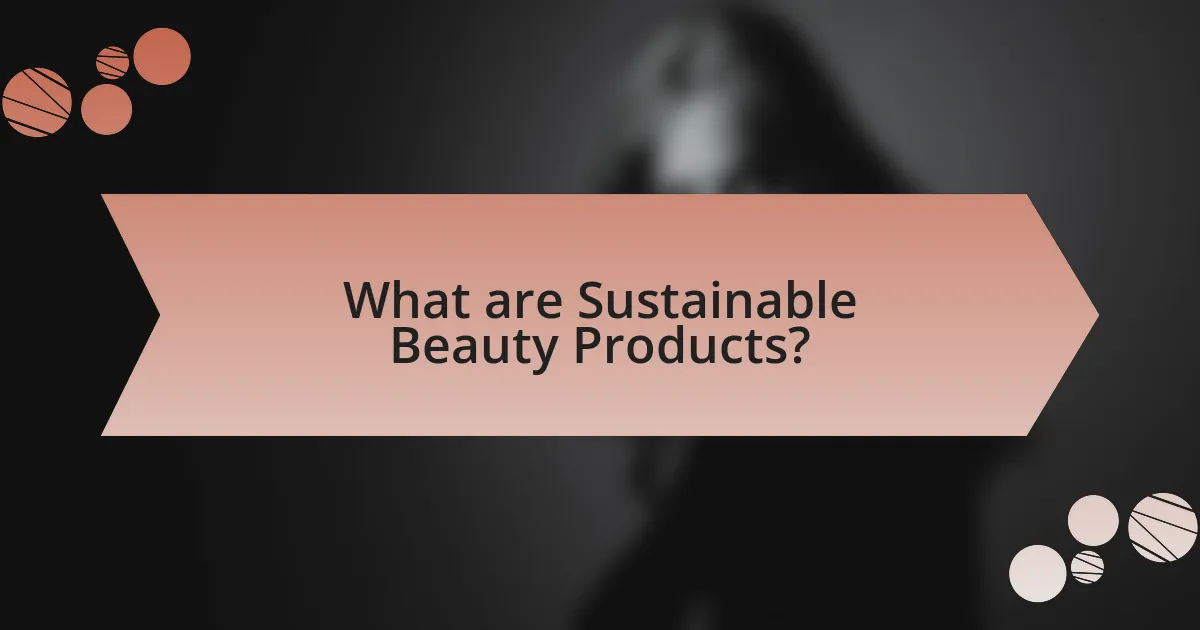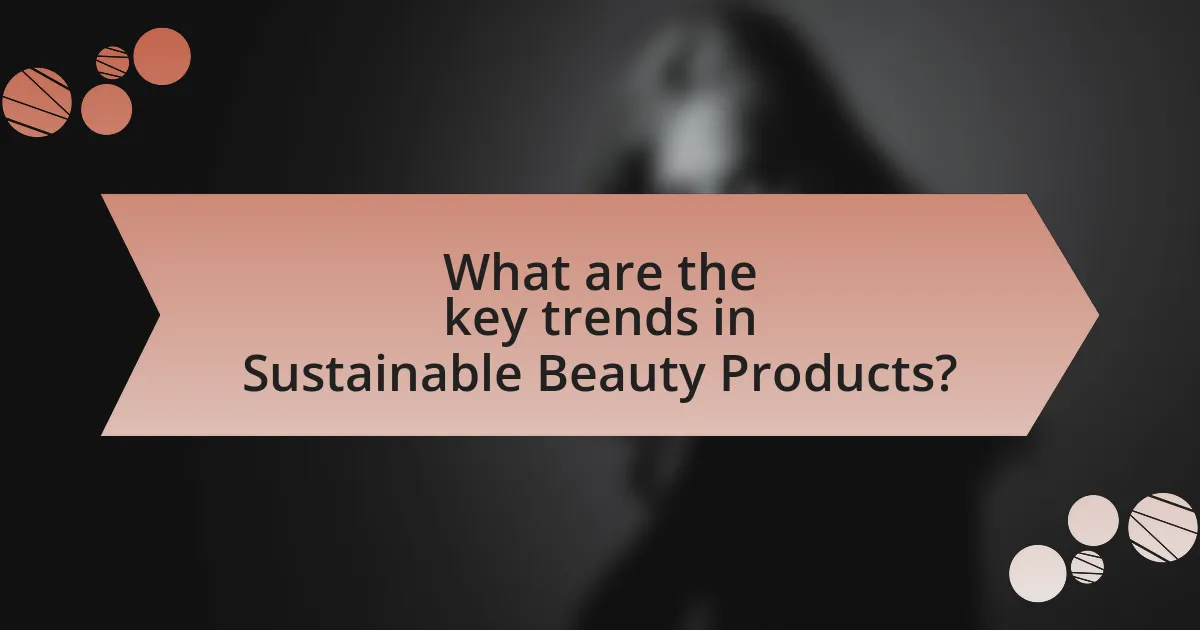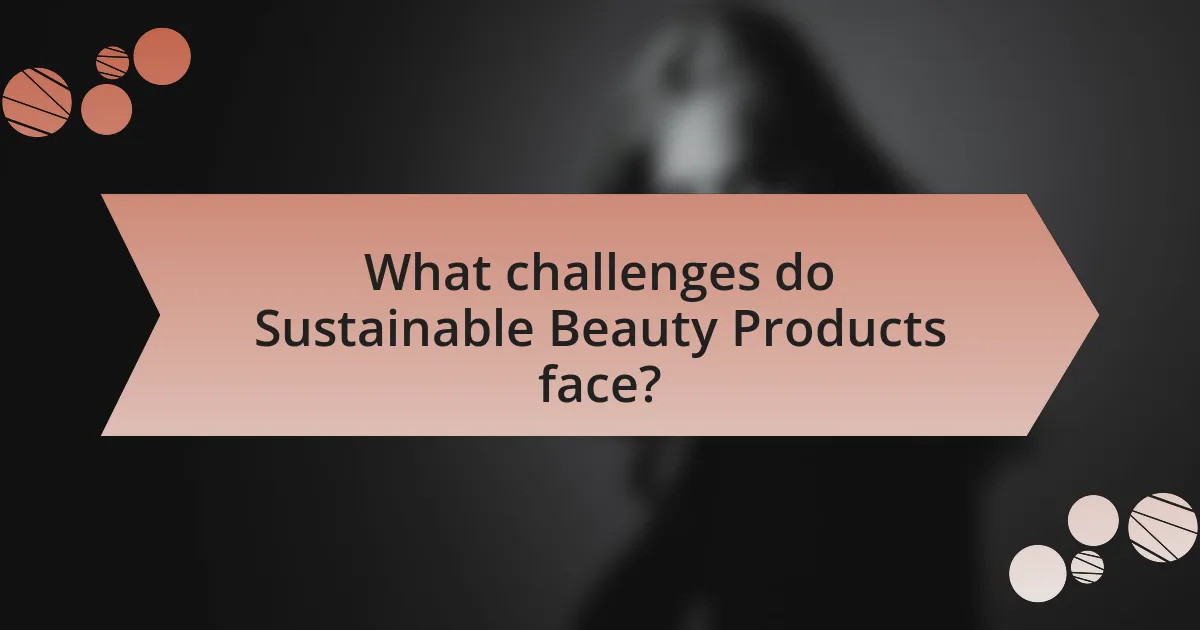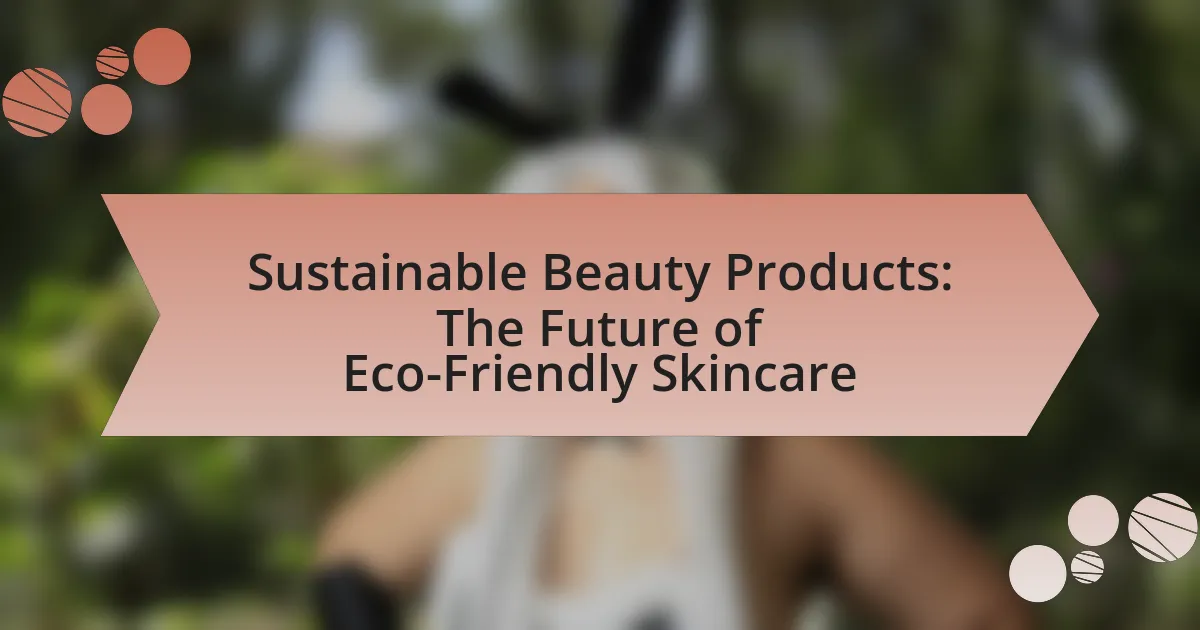Sustainable beauty products are cosmetics and personal care items formulated with environmentally friendly ingredients and practices, prioritizing natural, biodegradable components and minimal environmental impact. This article explores the differences between sustainable and traditional beauty products, common ingredients used, and the significance of sourcing practices. It also addresses the importance of sustainability in the beauty industry, key trends, and innovations, as well as the challenges and misconceptions surrounding sustainable beauty. Additionally, it provides insights on certifications that enhance consumer trust and offers guidance for consumers on making informed choices and supporting sustainable brands.

What are Sustainable Beauty Products?
Sustainable beauty products are cosmetics and personal care items formulated with environmentally friendly ingredients and practices. These products prioritize natural, biodegradable components, often sourced from renewable resources, and are produced with minimal environmental impact. For instance, brands may utilize recyclable packaging and avoid harmful chemicals, aligning with eco-conscious consumer demands. The global market for sustainable beauty products has been growing, with a report from Grand View Research indicating a projected CAGR of 9.7% from 2021 to 2028, reflecting increasing consumer awareness and preference for sustainable options.
How do Sustainable Beauty Products differ from traditional beauty products?
Sustainable beauty products differ from traditional beauty products primarily in their formulation and sourcing practices. Sustainable beauty products utilize natural, biodegradable ingredients and prioritize eco-friendly packaging, reducing environmental impact. In contrast, traditional beauty products often contain synthetic chemicals and may use non-recyclable packaging, contributing to pollution and waste. For example, a study by the Environmental Working Group found that many conventional cosmetics contain harmful substances like parabens and phthalates, which are avoided in sustainable formulations. This distinction highlights the commitment of sustainable beauty brands to environmental stewardship and consumer health.
What ingredients are commonly found in Sustainable Beauty Products?
Common ingredients found in sustainable beauty products include natural oils, plant extracts, and biodegradable materials. Natural oils such as jojoba, argan, and coconut oil provide moisturizing benefits while being derived from renewable sources. Plant extracts like aloe vera, green tea, and chamomile offer antioxidant and soothing properties, contributing to skin health without synthetic additives. Additionally, biodegradable materials such as candelilla wax and carnauba wax serve as eco-friendly alternatives to petroleum-based ingredients. These components are often sourced from sustainable practices, ensuring minimal environmental impact and promoting a healthier planet.
How do sourcing practices impact the sustainability of beauty products?
Sourcing practices significantly impact the sustainability of beauty products by determining the environmental and social footprint of the ingredients used. Sustainable sourcing involves selecting raw materials that are ethically harvested, minimizing ecological damage, and supporting local communities. For instance, the use of sustainably sourced palm oil can reduce deforestation and habitat destruction, as highlighted by the Roundtable on Sustainable Palm Oil, which reports that certified sustainable palm oil can help mitigate environmental impacts. Additionally, sourcing practices that prioritize organic and non-toxic ingredients contribute to lower chemical runoff and pollution, enhancing overall ecosystem health. Therefore, the choice of sourcing methods directly influences the sustainability profile of beauty products, affecting both environmental conservation and social responsibility.
Why is sustainability important in the beauty industry?
Sustainability is important in the beauty industry because it addresses environmental concerns and promotes ethical practices. The beauty industry significantly contributes to pollution and waste, with an estimated 120 billion units of packaging produced annually, much of which is not recyclable. By adopting sustainable practices, brands can reduce their carbon footprint, conserve resources, and minimize harmful impacts on ecosystems. Furthermore, consumers increasingly demand eco-friendly products, with 73% of millennials willing to pay more for sustainable offerings, indicating a market shift towards sustainability as a key factor in purchasing decisions.
What environmental issues are addressed by Sustainable Beauty Products?
Sustainable beauty products address several environmental issues, including plastic waste, chemical pollution, and resource depletion. These products often utilize biodegradable packaging to reduce plastic pollution, thereby minimizing landfill contributions. Additionally, they frequently contain natural ingredients that are less harmful to ecosystems, reducing chemical runoff into waterways. Furthermore, sustainable beauty brands often prioritize ethical sourcing of materials, which helps combat deforestation and promotes biodiversity. For instance, a report by the Ellen MacArthur Foundation highlights that the beauty industry contributes significantly to plastic waste, emphasizing the need for sustainable alternatives.
How do consumer preferences influence the shift towards sustainability?
Consumer preferences significantly influence the shift towards sustainability by driving demand for eco-friendly products. As consumers increasingly prioritize environmental concerns, brands are compelled to adopt sustainable practices to meet these expectations. For instance, a 2021 survey by McKinsey found that 67% of consumers consider sustainability when making purchasing decisions, indicating a strong market trend towards eco-conscious products. This shift prompts companies in the beauty industry to innovate and offer sustainable alternatives, such as biodegradable packaging and natural ingredients, aligning their offerings with consumer values and preferences.

What are the key trends in Sustainable Beauty Products?
Key trends in sustainable beauty products include the rise of clean ingredients, eco-friendly packaging, and transparency in sourcing. Clean ingredients focus on formulations free from harmful chemicals, with a growing demand for natural and organic components. Eco-friendly packaging emphasizes recyclable, biodegradable, or reusable materials, reflecting consumer preferences for reducing waste. Transparency in sourcing involves brands openly sharing information about ingredient origins and production processes, fostering trust and accountability. According to a 2021 report by Grand View Research, the global organic personal care market is expected to reach $25.11 billion by 2025, highlighting the increasing consumer interest in sustainable beauty.
How are brands innovating in the sustainable beauty space?
Brands are innovating in the sustainable beauty space by developing eco-friendly formulations, utilizing biodegradable packaging, and implementing transparent supply chains. For instance, companies like Lush and Aveda focus on using natural ingredients sourced sustainably, which reduces environmental impact. Additionally, brands such as Ethique and Plaine Products are leading the way with solid shampoo bars and refillable containers, minimizing plastic waste. Research indicates that the global sustainable beauty market is projected to reach $13.2 billion by 2025, highlighting the growing consumer demand for environmentally responsible products.
What role does packaging play in sustainable beauty innovations?
Packaging plays a crucial role in sustainable beauty innovations by minimizing environmental impact and enhancing product lifecycle. Sustainable packaging materials, such as biodegradable plastics and recycled paper, reduce waste and carbon footprint. For instance, a study by the Ellen MacArthur Foundation highlights that transitioning to sustainable packaging can significantly decrease plastic pollution, with companies like Unilever committing to using 100% recyclable or reusable packaging by 2025. This shift not only meets consumer demand for eco-friendly products but also aligns with global sustainability goals, demonstrating the integral role of packaging in advancing sustainable beauty practices.
How are technology and sustainability intersecting in beauty products?
Technology and sustainability are intersecting in beauty products through innovations that enhance eco-friendly practices and reduce environmental impact. For instance, advancements in biotechnology allow for the development of sustainable ingredients, such as lab-grown collagen, which minimizes reliance on animal sources. Additionally, smart packaging technologies, like biodegradable materials and refillable systems, are being implemented to reduce waste. According to a report by Grand View Research, the global green beauty market is expected to reach $22 billion by 2024, indicating a significant consumer shift towards sustainable options. This intersection not only promotes environmental responsibility but also meets the growing demand for transparency and ethical sourcing in the beauty industry.
What certifications and standards exist for Sustainable Beauty Products?
Certifications and standards for sustainable beauty products include the COSMOS certification, which ensures organic and natural cosmetic products meet strict environmental and ethical criteria. Another significant standard is the Ecocert certification, which verifies that products are made from natural ingredients and produced in an environmentally friendly manner. The Leaping Bunny certification guarantees that no animal testing is conducted at any stage of product development. Additionally, the USDA Organic seal indicates that a product contains at least 95% organic ingredients. These certifications are essential for consumers seeking transparency and assurance regarding the sustainability of beauty products.
How do certifications impact consumer trust in beauty products?
Certifications significantly enhance consumer trust in beauty products by providing verified assurance of quality and safety. When beauty products carry recognized certifications, such as organic, cruelty-free, or eco-friendly labels, consumers perceive these products as more credible and reliable. Research indicates that 73% of consumers are more likely to purchase products with certifications, as these labels often signify adherence to specific standards and ethical practices. This trust is further reinforced by the increasing demand for transparency in the beauty industry, where consumers seek products that align with their values regarding sustainability and ethical sourcing.
What are the most recognized certifications in the beauty industry?
The most recognized certifications in the beauty industry include the Leaping Bunny certification, USDA Organic certification, and EcoCert certification. The Leaping Bunny certification signifies that a product is cruelty-free and has not been tested on animals, which is crucial for consumers concerned about animal welfare. The USDA Organic certification indicates that a product contains at least 95% organic ingredients, ensuring that it meets strict agricultural standards. EcoCert certification verifies that products are made from natural and organic ingredients, promoting environmentally friendly practices. These certifications are widely acknowledged and help consumers make informed choices about sustainable beauty products.

What challenges do Sustainable Beauty Products face?
Sustainable beauty products face several challenges, including high production costs, limited availability of sustainable ingredients, and consumer skepticism. High production costs arise from sourcing eco-friendly materials and implementing sustainable practices, which can lead to higher retail prices compared to conventional products. Limited availability of sustainable ingredients restricts manufacturers’ ability to create diverse product lines, as not all ingredients can be sourced sustainably or in sufficient quantities. Consumer skepticism is fueled by greenwashing, where brands falsely claim to be sustainable, leading to distrust among consumers regarding the authenticity of sustainable claims. These challenges hinder the growth and acceptance of sustainable beauty products in the market.
What are the common misconceptions about Sustainable Beauty Products?
Common misconceptions about sustainable beauty products include the belief that they are always more expensive, less effective, and that all natural ingredients are inherently safe. Many consumers think sustainable products come with a higher price tag; however, studies show that the cost can vary widely, and some sustainable brands offer competitive pricing. Additionally, the effectiveness of sustainable beauty products is often underestimated; research indicates that many eco-friendly formulations perform just as well as conventional ones. Lastly, while natural ingredients are often perceived as safer, not all natural substances are non-toxic, as evidenced by the presence of harmful compounds in some plant-derived ingredients.
How do price points affect consumer adoption of sustainable products?
Price points significantly influence consumer adoption of sustainable products, as higher prices often deter potential buyers due to perceived affordability issues. Research indicates that consumers are generally willing to pay a premium for sustainable products, but this willingness varies based on income levels and product categories. For instance, a study published in the Journal of Consumer Research found that 66% of consumers are willing to pay more for sustainable products, yet price sensitivity remains a critical barrier, particularly in lower-income demographics. Therefore, while competitive pricing can enhance adoption rates, excessive price points can limit market penetration and consumer engagement with sustainable beauty products.
What barriers do brands encounter when transitioning to sustainable practices?
Brands encounter several barriers when transitioning to sustainable practices, including high costs, supply chain complexities, and consumer skepticism. High costs arise from the need for investment in sustainable materials and technologies, which can significantly increase production expenses. Supply chain complexities involve sourcing eco-friendly materials, which may not be readily available or may require new partnerships, complicating logistics and operations. Consumer skepticism can hinder acceptance of sustainable products, as customers may doubt the authenticity of sustainability claims or be unwilling to pay a premium for eco-friendly options. These barriers collectively challenge brands in their efforts to adopt sustainable practices effectively.
How can consumers make informed choices about Sustainable Beauty Products?
Consumers can make informed choices about sustainable beauty products by researching ingredients, understanding certifications, and evaluating brand transparency. Researching ingredients allows consumers to identify harmful chemicals and prioritize natural, biodegradable components. Understanding certifications, such as USDA Organic or Leaping Bunny, helps consumers recognize products that meet specific sustainability standards. Evaluating brand transparency involves assessing how openly brands communicate their sourcing practices, manufacturing processes, and environmental impact, which can be verified through third-party audits or sustainability reports. These steps empower consumers to select products that align with their values and contribute to environmental sustainability.
What tips can help consumers identify truly sustainable products?
To identify truly sustainable products, consumers should look for certifications such as Fair Trade, USDA Organic, or Cradle to Cradle, which indicate adherence to environmental and ethical standards. These certifications are backed by rigorous assessments that ensure products meet specific sustainability criteria, such as responsible sourcing, minimal environmental impact, and fair labor practices. Additionally, consumers can examine ingredient lists for natural, biodegradable components and avoid products with harmful chemicals, as these often indicate a lack of sustainability. Research shows that products with fewer synthetic ingredients are generally more eco-friendly, aligning with the principles of sustainable beauty.
How can consumers support brands committed to sustainability?
Consumers can support brands committed to sustainability by choosing to purchase products from companies that prioritize eco-friendly practices. This includes looking for certifications such as Fair Trade, USDA Organic, or cruelty-free labels, which indicate a brand’s commitment to ethical sourcing and production. Additionally, consumers can engage with brands on social media, providing feedback and encouraging transparency about their sustainability efforts. Research shows that 66% of global consumers are willing to pay more for sustainable brands, highlighting the market demand for eco-conscious products. By actively supporting these brands, consumers contribute to a larger movement towards sustainable practices in the beauty industry.
What are the best practices for incorporating Sustainable Beauty Products into a skincare routine?
To effectively incorporate sustainable beauty products into a skincare routine, prioritize products with eco-friendly ingredients and packaging. Selecting items that are certified organic or cruelty-free ensures that they meet environmental and ethical standards. Additionally, consider the product’s lifecycle, opting for brands that utilize sustainable sourcing and production methods. Research shows that consumers increasingly prefer brands that demonstrate transparency in their ingredient lists and environmental impact, with 66% of global consumers willing to pay more for sustainable brands (Nielsen, 2015). Regularly assess your skincare routine to eliminate products that do not align with sustainable practices, thereby reducing waste and promoting a more eco-conscious lifestyle.
